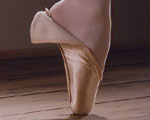Fleming provides
rigorous and systematic categories which aid in the examination of objects.
He propsoses that all the significant characteristics of an object can be
explored and and related by looking at five basic properties: History, Material,
Construction, Design, and Function. Fleming
advises that these five properties be examined by applying four different
operations: Indentification, Evaluation, Cultural Analysis, and Interpretation.
However, I believe these areas are covered more effectively by the other
theorists I have selected.
Property |
Description
|
History |
This property is not
extremely illuminating at this point. Undoubtedly, once I have done
more research it may prove more useful. The historical information
that Fleming seems interested in here applies to the area of provenance
and unique objects. It is less useful when approaching generic objects
like shoes, or pointe shoes, in particular. |
Material |
The basic components
used in the manufacture of pointe shoes are satin, paper and hessian,
which are used to form the block, and the leather sole. Two layers
of canvas line the interior of the shoe. Satin encases the exterior
of the shoe and is usually flesh-coloured. Hessian and paper form
the “block” or hard toe of the shoe. The leather used
to form the sole or shank comes in varying degrees of stiffness
but, overall, is quite rigid. |
Construction |
The block, or hard toe
of the shoe, is usually formed by hand, building it up layer by
layer using hessian triangles, paper and glue. The basis of the
glue is commonly a simple flour and water paste. After the block
is formed, the shoe is then stitched, joining the leather sole to
the satin casing or upper. The insole is then inserted into the
shoe. At this stage, the glue in the block is not yet dry and hard.
This allows the maker to fashion and shape the block with the aid
of a smooth hammer, creating the “platform” or flattened
tip of the shoe. The shoe is then placed into an "oven"
overnight where it bakes and hardens. |
Design |
While a fine fabric,
the satin that makes up the outer casing of the pointe shoe tends
to be unadorned and flesh-coloured. The ribbons, which are wrapped
around the top of the foot and ankle are also of satin. This decorative
aspect fulfills two functions (discussed in the next section). |
Function |
The stiff block encompassing
the toe area of the shoe has a flattened tip or “platform,”
which allows the dancer to shift her weight to the tips of her toes,
en pointe, and balance more easily. Ribbons, which the dancer sews
on herself, hold the shoe in place as well as add stability to the
ankle. The leather shank is quite stiff and lends stability to the
foot as well. However, the shank is “broken” by some
dancers – by strategically breaking the shank, the foot is
able to bend more easily, lending a more attractive arch to the
foot. It is questionable whether satin is the best fabric for pointe
shoes. It is quite delicate and tends to fray at the toe-tip where
the greatest degree of stress occurs. However, it is smooth and
a little slippery, which allows for greater ease in turning and
shifting weight. The colour of the shoe, when combined with pink
tights (another common item of clothing for dancers), makes the
leg look long and continuous, effacing the foot. |
|
